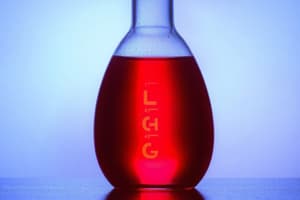Podcast
Questions and Answers
What is the nature of gas molecules in terms of their mass and size?
What is the nature of gas molecules in terms of their mass and size?
- They are negligible in size compared to the distance between them. (correct)
- They have fixed positions and cannot move.
- They vary significantly in size and mass between different gases.
- They have substantial mass and larger size.
How would you characterize the speed of gas molecules?
How would you characterize the speed of gas molecules?
- Gas molecules are stationary at lower temperatures.
- Gas molecules have a maximum velocity that they cannot exceed.
- Gas molecules move slowly and consistently at a predetermined speed.
- The speed varies between zero and extremely high values. (correct)
What determines the mean free path of gas molecules?
What determines the mean free path of gas molecules?
- The volume of the gas and the temperature.
- The gravitational forces acting on the molecules.
- The distance traveled by molecules before colliding. (correct)
- The size of the gas molecules and the frequency of collisions.
Which statement accurately describes the forces acting on gas molecules?
Which statement accurately describes the forces acting on gas molecules?
What is the significance of the number of collisions per unit volume in a gas?
What is the significance of the number of collisions per unit volume in a gas?
Flashcards are hidden until you start studying
Study Notes
Properties of Gas Molecules
- Gases consist of tiny particles called molecules, which are identical within a specific gas and differ between different gases.
- Gas molecules are described as identical, spherical, rigid, and behave as perfectly elastic point masses during collisions.
Molecular Size and Distance
- The size of gas molecules is negligible when compared to the distances between them, leading to a low density.
- The distance a molecule travels between successive collisions is termed the 'free path', while the average of all free paths in a gas is referred to as the 'mean free path'.
Molecular Motion and Collisions
- Gas molecules possess a wide range of speeds, with velocities fluctuating between zero and significantly high values.
- The number of collisions occurring per unit volume in a gas remains constant, indicating steady molecular activity.
Molecular Interaction
- Gas molecules do not experience attractive or repulsive forces during motion, allowing for independent behavior.
- Gravitational forces are negligible among gas molecules due to their small masses and high-speed dynamics, rendering any potential attraction ineffective.
Studying That Suits You
Use AI to generate personalized quizzes and flashcards to suit your learning preferences.




